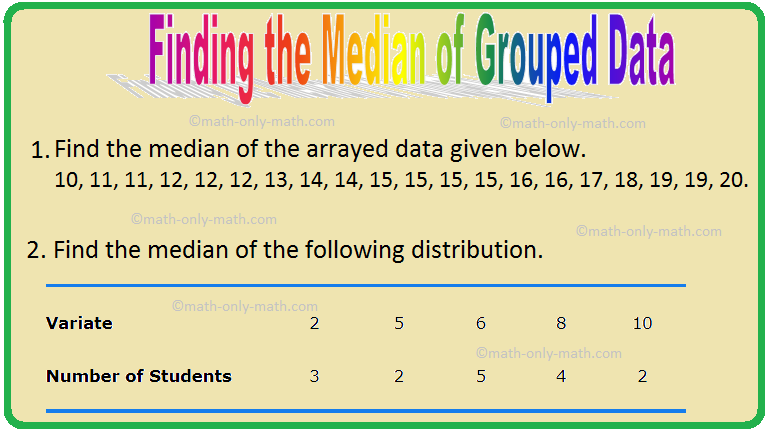Subscribe to our ▶️ YouTube channel 🔴 for the latest videos, updates, and tips.
Finding the Median of Grouped Data
To find the median of arrayed (grouped) data we need to follow the following steps:
Step I: Arrange the grouped data in ascending or descending order, and form a frequency table.
Step II: Prepare a cumulative-frequency table of the data.
Step III: Select the cumulative frequency that is just greater than \(\frac{N}{2}\), where N is the total number of observations (variates). Then find the median as follows.
The variate whose cumulative frequency is the selected cumulative frequency, is the median of the data.
If \(\frac{N}{2}\) is equal to the cumulative frequency of a variate then
median = mean of this variate and the variate just greater than it.
Solved Examples on Find the Median of Grouped Data /Arrayed Data:
1. Find the median of the following distribution.
Variate
2
5
6
8
10
Number of Students
3
2
5
4
2
Solution:
Here, the frequency distribution is given.
The cumulative-frequency table of the distribution is
|
Variates 2 5 6 8 10 |
Frequency 3 2 5 4 2 N = 16 |
Cumulative Frequency 3 5 10 14 16 |
Here, \(\frac{N}{2}\) = \(\frac{16}{2}\) = 8.
The cumulative frequency just greater than 8 is 10.
The variate whose cumulative frequency is 10 is 6.
Therefore, the median = 6.
2. Find the median of the arrayed data given below.
10, 11, 11, 12, 12, 12, 13, 14, 14, 15, 15, 15, 15, 16, 16, 17, 18, 19, 19, 20.
Solution:
Putting the data in a frequency table, we have the cumulative frequencies as below.
Here, the total frequency N = 20.
So, \(\frac{N}{2}\) = \(\frac{20}{2}\) = 10.
The cumulative frequency just greater than 10 is 13 and the corresponding variates is 15. So, the median = 15.
From Finding the Median of Grouped Data to HOME PAGE
Didn't find what you were looking for? Or want to know more information about Math Only Math. Use this Google Search to find what you need.




New! Comments
Have your say about what you just read! Leave me a comment in the box below. Ask a Question or Answer a Question.